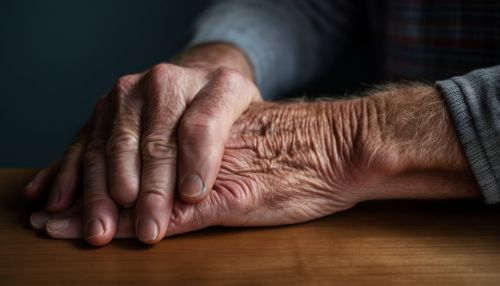Parkinson's Disease
Introduction
Parkinson's disease (PD) is a long-term degenerative disorder of the central nervous system that primarily affects the motor system. The symptoms usually emerge slowly and, as the disease progresses, non-motor symptoms become more common. The most obvious early symptoms are tremor, rigidity, slowness of movement, and difficulty with walking, but cognitive and behavioral problems may also occur. PD is more common in the elderly with most cases occurring after the age of 50.


Etiology
The cause of Parkinson's disease is generally unknown, but believed to involve both genetic and environmental factors. Those with a family member affected are more likely to get the disease themselves. There is also an increased risk in people exposed to certain pesticides and among those who have had prior head injuries. The motor symptoms of the disease result from the death of cells in the substantia nigra, a region of the midbrain, leading to a dopamine deficit.
Pathophysiology
The pathophysiology of Parkinson's disease involves the loss of dopamine-producing neurons within the substantia nigra. This neuronal loss leads to a disruption of the normal balance between dopamine and other transmitters, such as acetylcholine. This disruption leads to the motor symptoms characteristic of the disease. The reason for this cell death is poorly understood, but involves the build-up of proteins into Lewy bodies in the neurons.
Diagnosis
Diagnosis of Parkinson's disease is usually based on symptoms, with tests such as neuroimaging used to rule out other diseases. There is no definitive test for Parkinson's disease, and the diagnosis is clinical, with symptoms of the disease having to be present for at least six months. It is often complicated by the fact that other conditions can cause similar symptoms, and the disease may be misdiagnosed in the early stages.
Treatment and Management
There is currently no cure for Parkinson's disease, but medications, surgery, and multidisciplinary management can provide relief from the symptoms. Medications used include: levodopa, dopamine agonists, and MAO-B inhibitors. The most commonly used surgical treatment is deep brain stimulation (DBS), which involves the implantation of a medical device that sends electrical impulses to specific parts of the brain. Multidisciplinary management involves a team of health professionals including a neurologist, physiotherapist, and occupational therapist, and can include a range of therapies such as physiotherapy, occupational therapy, and speech therapy.
Prognosis
The progression of symptoms in Parkinson's disease is often a bit different from one person to another due to the diversity of the disease. People with PD may experience 'on-off' symptoms where they feel better for a while, then worse. Predicting when these fluctuations will occur can be difficult. Some people with Parkinson's disease live for many years with the disease, while others may have a more rapid progression. A number of factors, including a person's age and general health status, can influence the progression of the disease.
Epidemiology
Parkinson's disease affects about 1% of people over the age of 60, making it the second most common aging-related disorder after Alzheimer's disease. It is more common in the elderly and rates rise from 1% in those over 60 years of age to 4% of the population over 80. The mean age of onset is around 60 years, although 5–10% of cases are early-onset PD, beginning before the age of 50. Males are more likely than females to develop Parkinson's disease.
History
The disease was first recognized and its symptoms documented in 1817 in An Essay on the Shaking Palsy by the British physician James Parkinson. It was 60 years later, in 1877, that French neurologist Jean-Martin Charcot expanded on Parkinson's findings, distinguishing between rigidity, weakness and bradykinesia (slowness of movement). He also championed the renaming of the disease in honor of Parkinson.
Research Directions
Research into Parkinson's disease is ongoing, with a focus on better understanding the mechanisms of neuronal death, the role of genetic and environmental factors, and the development of new treatments. There is also a significant amount of research being conducted into the potential of stem cell therapy for the treatment of Parkinson's disease.
